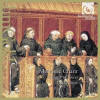Texte paru dans: / Appeared in: |
|
|
Reviewer: J.
F. Weber This is not actually the first recording to be based on Edward Roesner's new edition of the Magnus Liber Organi for Oiseau-Lyre Press. That distinction belongs to Haec Dies: Easter at Notre Dame Paris recorded by Les Six ensemble on Move MD 3144, but the latter disc can only be ordered directly from Australia. Nor is this based solely on Roesner's edition, for it also includes music from earlier twelfth-century polyphonic sources at St. Martial and Compostela. These were prepared after consulting the recent editions by Theodore Karp {Fanfare 16:5, p. 447) and Henrik van der Werf (“very different,“ as Hillier describes them—not to say diametrically opposed). It also includes Aquitainian monody edited by Leo Treitler and sequences by Adam of St. Victor in Pierre Aubry's classic old edition. The two sequences by Adam of St. Victor are both discussed by Margot Fassler in Gothic Song. In natale Salvatoris for Christmas is based on an important Victorine sequence for Easter, Zima vetus, while Templům cordis for the feast of the Purification, one of six set to the melody of O Maria, stella maris, is a piece that Fassler discussed in her dissertation. Neither of these two has been recorded before. The inclusion of three polyphonic pieces from the St. Martial repertoire is useful, since so little of this material has been recorded. These all appear on disc for the first time. The only other recent issue, Mille Anni di Musica, a splendid three-disc set issued this year by the magazine Amadeus in Milan, offers three other pieces all previously recorded—Mira lege, which I haven't heard since the 1930 recording, and two pieces already found in Marcel Pérès's Aquitainian disc (Fanfare 11:6, p. 308). The recent disc titled Campus Stellae (18:5, p. 397) had two pieces not recorded before. The only selection from Compostela, however, is the most familiar of all, Congaudeant catholici, included because of its attribution to the Notre Dame cantor, Albert of Paris. The Notre Dame repertoire on this disc is interesting. In his disc devoted to Pérotin (13:4), Hillier included Beata viscera, a strophic conductus for one voice (attributed to Perotinus with text by Philip the Chancellor), one that might have been inserted into a Marian feast day Mass. That recording contained only the hrst two and last two of the seven strophes sung here. (Dominique Vellard, on his École de Notre Dame de Paris disc, included the first five strophes.) The clausula Mors is important because it is the only four-voice piece other than the two graduais (Viderunt and Sederunt) to be found in the Notre Dame repertoire, attributed to Perotinus; it is seldom recorded. On recordings by the Deiler Consort and Ensemble Venance Fortunatus ( 10:4, p. 258), it was better situated within the chant Alleluia Christus resurgens. Propter veritatem, attributed to Leoninus, will be remembered from Russell Oberlin's recently reissued Notre Dame record (18:1, p. 407). Hence the Notre Dame sections of this program are representative of the polyphony credited to the two big names of the period as well as monophonie pieces of the same period. The performances by the eight men of the present group are superb, not surprising after hearing the level to which the Theatre of Voices has risen with their most recent recordings. Hillier, too, has gained new recognition with his appointment as successor to the late Thomas Binkley at Indiana's Early Music Institute. Vae mundo is reproduced in color from the Florence MS., a beautiful pair of pages (too small on the booklet page, unfortunately) that shows how unsatisfactory the only facsimile edition is. Another page had been reproduced in color in Music for the Lion-Hearted King. A color facsimile of the Florence MS. on microfiche has just been announced, no doubt the source of the color reproductions in this booklet. The sound originated in San Rafael. California, at a chapel that has attracted several early-music groups for recording. The notes by Edward Roesner, though too brief, are concise and helpful, and texts come with translations. At 132 pages, the slipcased booklet is lavish with legible lettering. This is decidedly my favorite Theatre of Voices production to date.
| |
|
|
|
|
|
|
|
Cliquez l'un ou l'autre
bouton pour découvrir bien d'autres critiques de CD |
|




